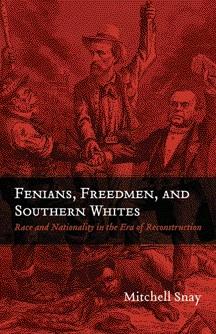Fenians, freedmen, and Southern whites: race and nationality in the era of Reconstruction
Published in 18th-19th Century Social Perspectives, 18th–19th - Century History, Book Reviews, General, Irish Republican Brotherhood / Fenians, Issue 6 (Nov/Dec 2008), Reviews, Volume 16 Fenians, freedmen, and Southern whites: race and nationality in the era of Reconstruction
Fenians, freedmen, and Southern whites: race and nationality in the era of Reconstruction
Mitchell Snay
(Louisiana State University Press, $40)
ISBN 9780807132739What do Southern Klansmen, their politically aroused former slaves and American-based Irish nationalists have in common? Not a lot, it turns out. Mitchell Snay aspires in this ambitious comparative study to tease out a common thread of struggles for ‘ethnic autonomy and political self-governance’ among the Fenians and two of the central protagonists in the post-emancipation US South, the white paramilitaries organised in the Ku Klux Klan and the Republican Party-affiliated Union Leagues, made up overwhelmingly of freed slaves. Resting on impressive research, the study succeeds in illuminating the capacity of American civic nationalism, recast and augmented by northern victory in the Civil War, to submerge ethnic and racial antagonisms under its ‘hegemonic force’ (p. 175). In five chapters that range over an extensive secondary literature, Snay delivers a number of compelling insights—not least in his sensitive engagement with the Fenians. But despite these real strengths one comes away feeling that there are too many square pegs being forced into round holes.
The basic premise of the study is that ‘new meanings for Reconstruction’, the period that followed slave emancipation in the United States, can be gleaned through a comparative examination of these three very different movements, whose common element, Snay suggests, is ethnic or racial nationalism. Its most salient assertion, that the Civil War ‘was a modernising experience’ that ‘raised the aspirations of groups who had recently been marginalised from the [American] mainstream’, is a sound and potentially fruitful one. But it is also problematic, particularly when applied to the two contending parties in the South.
At some level of abstraction, the Klan and its direct adversaries may appear as parallel movements or mirror images based on nationalism, but whether there is anything to be gained by obscuring their obvious differences is another question. The composition of the Klan varied across the South, but in most places it was initiated, and for a time led, by local planters, the very opposite of a ‘marginalised’ group in Southern society. United around a zealous commitment to restoring white supremacy, it was inherently based on racial exclusivity. By contrast, the Union Leagues were formally committed to equal citizenship and in the mountain South comprised mainly of whites. Snay is mindful of these incongruities, but seems unwilling to acknowledge that at some point they strain the limits of his conceptual framework. The substantial recent literature that has reframed Reconstruction as a problem in labour and class relations suggests a basic asymmetry in the tumult that gripped the region—one frequently played out under the banner of race but which reflected a fundamental divide over access to wealth and property. The author acknowledges this trend in the historiography but proceeds with an analysis that largely ignores it.
The Fenians figure in the central drama of the period only indirectly. The reconfiguration of American republicanism after emancipation inaugurated an important shift in Irish-American politics, the author argues persuasively: while before the war Famine-era immigrants had been notoriously allied with the most bigoted elements of the Democratic Party, the post-bellum period saw an opening up of Irish loyalties, with important effects on the Fenians. John Mitchell and others remained ardent supporters of the Democrats and evinced little sympathy for the former slaves, but Fenianism did not speak with a single voice on these issues, and Snay suggests that their embrace of universalist conceptions of freedom mitigated against the kind of narrow nationalism that their detractors have too blithely ascribed to them. ‘Throughout the 1860s’, he writes, ‘American Fenians consistently maintained that the fight for Irish independence was part of a larger worldwide struggle for liberty’ (p. 129). ‘[F]or us to claim liberty for Ireland while denouncing the liberation of the negroes’, members of the Emmett Circle in Iowa suggested, ‘is a species of inconsistency too intolerant and palpable to pass the scrutiny of any intelligent people’ (p. 14). Clearly there was an important debate under way in what had formerly appeared as a cohesive Irish-American community, and Snay’s assertion that this was spurred by the upheaval brought on by slave emancipation seems on the mark, as is his important suggestion that the ‘normative nationalism’ promoted by the Republican Party helped to ‘channel separatist impulses along the lines of civic nationalism while discouraging them along ethnic lines’ (p. 170).
While Fenians, freedmen, and Southern whites ultimately falls short of proving a common aspiration for ethnic or racial autonomy among these three very different groups, it is nevertheless a rewarding read with much to offer, including some astute observations on the state of Irish-American nationalism at a time of ideological flux. Mitchell Snay brings an impressive grasp of his sources to bear in the study, and in places offers nuanced and original perspectives on some heavily travelled historiography. But ultimately one gets the sense that these obvious strengths have been wedged into an interpretive structure that does not do justice to the author’s wide knowledge and obvious capacity for perceptive scholarship.
Brian Kelly lectures in history at Queen’s University, Belfast.
















